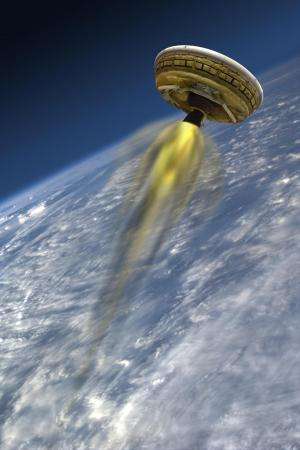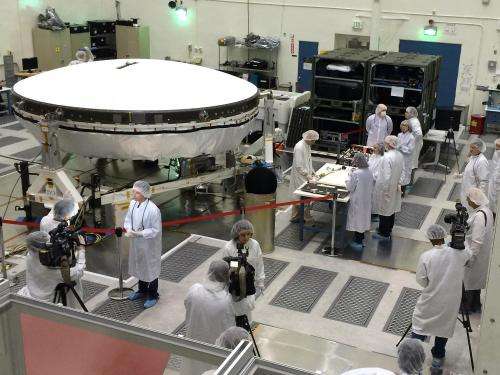April 1, 2015 report
'Flying saucer': NASA live-streamed Low-Density Supersonic Decelerator test

(Phys.org)—NASA live-streamed a balance test conducted on the Low-Density Supersonic Decelerator (LDSD) spacecraft yesterday (after a two hour delay) to ensure the 15 foot diameter flying saucer-looking craft will be balanced when it is sent aloft over Hawaii in just a few weeks. The LDSD is a new space exploration craft that is part of NASA's mission to build a much larger vehicle for landing on the surface of Mars than those that carried probes such as the Rover missions—large enough to carry people.
NASA has conducted one launch test thus far of the current LDSD design, also over Hawaii—in that test the parachute was torn apart shortly after it was deployed, preventing the craft from landing softly. The research team believes they have solved that problem and are now preparing to conduct another launch test. The launch tests involve carrying the 7000 pound craft to an altitude of 160,000 feet by a balloon—once deployed rockets carry it to an altitude of 200,000 feet at which point it attempts to fall back and land—spinning as it does so, to help keep it aligned correctly.
The new saucer shape is meant to help increase drag, thus slowing the craft—it has bags on its edge that inflate very rapidly that serve to increase the surface area of the craft, further increasing drag. Engineers on the project expect the craft to slow to Mach 2, due to drag—once that point is reached, a long parachute opens, slowing the craft enough for a soft landing. At 200,000 feet the air is thin enough to simulate the thin atmosphere on Mars.
The balance test, conducted at NASA's JPL Laboratory near Los Angeles CA, was done to ensure the craft would spin without wobbling once sent aloft—it was live-streamed to allow space enthusiasts to watch and chat amongst themselves as a real test was conducted. NASA and project reps were on hand to answer questions posed by journalists invited to view the test and those by users online. The test consisted of spinning the craft on a central point, similar to that done to balance tires on a car.

More information: — www.nasa.gov/jpl/ldsd/take-a-s … echnology/index.html
© 2015 Phys.org





















